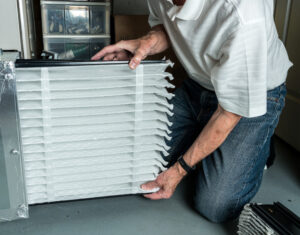MERV 8 vs Merv 11 vs Merv 13: Which is Best?

*Updated March 10th, 2025
As a homeowner, you know your HVAC system needs air filters, but did you know there are different ratings, including MERV 8, 11, and 13? The different filter ratings affect the air quality in your home and could affect how you and your household members feel.
A good air filter is the first line of defense against air pollution, but choosing the wrong air filter has the potential to put too much pressure on your system.
According to the American Lung Association, indoor air can be as much as 100 times more polluted than outdoor air. This can cause problems for anyone, not to mention those who suffer from allergies or asthma.
However, by choosing the right air filter, you can improve the air your family members breathe and decrease the risk of respiratory issues. The more filtered your air is, the better it is for your health
Understanding the difference between MERV 8, MERV 11, and MERV 13 air filters and how they affect your family and HVAC system are the key to choosing the best filters.
Table of Contents
What is a MERV rating?
MERV stands for Minimum Efficiency Reporting Value. It rates a filter’s ability to capture particles, such as dust, pet dander, viruses, and mold. The rating comes from the American Society of Heating, Refrigerating, and Air Conditioning Engineers and can help you choose the right filter for your home.
The MERV rating ranges from 1 – 16 and the higher the number, the smaller the microns the filters can capture. MERV ratings are based on a filter’s ability to capture microns measuring 0.3 to 10 microns. The smaller the microns a filter can capture, the cleaner the air in the house.
To help put the size into perspective, a piece of human hair is 100 microns, as is the thickness of a standard piece of paper. At half that size, we cannot see the pollutant with the naked eye, and a dust mite can measure just 10 microns, but most are five or less.
Basic air filters can capture large particles (up to 10 microns), but if you have highly sensitive household members, choosing an air filter with better capturing abilities may be necessary for their overall health.
The average homeowner uses air filters with an 8 MERV rating. However, households with highly sensitive individuals with allergies or asthma may opt for higher MERV ratings as high as 13.
Overview of MERV 8 Filters
MERV 8 filters are one of the most common air filters homeowners choose. While a common choice, they have advantages and disadvantages to understand.
Definitions and Characteristics
According to the EPA, a MERV 8 filter can capture up to 70% of microns measuring 3.0 – 10.0 microns and 20% measuring 1.0 – 3.0. This is usually sufficient for a standard home with no concerns about asthma or allergies.
Because it cannot filter microns smaller than 1.0 and only captures 20% of those between 1.0 and 3.0, many standard pollutants, including pet dander and airborne bacteria, can pass through the filter. This isn’t an issue for most people, but allergy sufferers or those with chronic health conditions may need something better.
Advantages
- Captures most standard household pollutants, including dust, pollen, and pet hair
- Captures a majority of large particles
- Priced well
Limitations
- May not be strong enough for people with allergies
- Lets through things like pet dander and certain bacteria
Overview of MERV 11 Filters
MERV 8 filters are the most basic filter and the one many homeowners choose. They are the safest for most HVAC systems, but they may let harmful particles through, which could bother sensitive individuals. MERV 11 filters are a step up from MERV 8, capturing more large particles and helping capture smaller particles.
Definitions and Characteristics
MERV 11 filters are a step up from MERV 8 filters, capturing an even larger number of pollutants. MERV 11 filters capture up to 85% of 3.0 – 10.0 microns, 65% of 1.0 – 3.0 microns and 20% of 0.30% – 1.0 microns. So they capture much smaller particles than MERV 8 and a larger number of standard particles larger than 3.0 microns.
MERV 11 filters are common for pet owners as they are more likely to capture pet hair and some pet dander.
Advantages
- May eliminate smaller dust and bacteria particles
- Helps capture sneeze bacteria
- Can be good for people with allergies
Limitations
- Restricts the airflow, which can make the HVAC system work harder
- Can be too much filtration for households without pets or allergy issues
Overview of MERV 13 Filters
MERV 13 filters are the highest most HVAC systems can go, and they should be used only when the manufacturer’s directions specifically state that they are acceptable.
Definitions and Characteristics
According to the EPA, MERV 13 filters capture 90% of 3.0 – 10.0 microns, 85% of 1.0 – 3.0 microns, and 50% of 0.3 – 1.0 microns. Thus, they provide the best protection against airborne bacteria and viruses.
They are recommended for families with newborn babies, household members who smoke, or household members with severe allergies or chronic health conditions.
Advantages
- Can provide the cleanest environment for at-risk individuals
- May catch microscopic allergens
- Captures up to 90% of large particles
Limitations
- If used against the manufacturer’s suggestion, it could cause premature HVAC system failure
- Higher cost than MERV 8 or MERV 11 filters
Comparison Between MERV 8, 11, and 13 Filters
Consider what you’re trying to filter when choosing between MERV 8 vs MERV 11 and MERV 13. The higher the MERV rating, the smaller the particles the filter can capture.
However, you should only choose the MERV rating that captures the particles most bothersome for your household members, opting for MERV 8 if you don’t have any special concerns.
If you choose a higher MERV rating, be sure to change your filter more frequently. The more particles a filter captures, the less airflow it allows.
The more you restrict your airflow, the more damage you can do to your HVAC system. Regularly changing your filters and getting an HVAC inspection ensures the health of your system.
How Often Should You Change Your Air Filter?
The efficiency of your air filter depends on how often you replace it. Over time, filters become clogged with dust, pet hair, and other pollutants, reducing their effectiveness and straining your HVAC system. Here’s a general guideline for filter replacement:
- MERV 8 Filters: Change every 60-90 days in an average household. If you have pets, aim for 30-60 days.
- MERV 11 Filters: Change every 30-60 days, especially if you have pets or allergy sufferers in the home.
- MERV 13 Filters: Change every 30-45 days since they trap the most particles and clog faster.
If you notice reduced airflow, increased dust, or worsened allergy symptoms, it may be time to replace your filter sooner than recommended.
Signs You May Need a Higher MERV Rating
If you’re unsure whether upgrading your air filter is necessary, here are some common signs that your home may benefit from a higher MERV rating:
Frequent allergy or asthma flare-ups – If household members experience worsening symptoms, a MERV 11 or 13 filter can help trap airborne allergens.
Excessive dust buildup – If you’re constantly dusting furniture, a higher MERV filter could reduce the amount of dust circulating in your home.
Musty or stale indoor air – If your home’s air feels heavy or stale, a better filter can help remove fine pollutants.
Pets in the home – If you have dogs or cats, a MERV 11 or 13 filter can help capture pet dander more effectively.
Nearby construction or high outdoor pollution – Homes in areas with high pollution or construction dust may benefit from a higher MERV filter.
Factors to Consider When Choosing Between MERV Ratings
When choosing the best MERV rating for your home, consider the following factors.
Specific air quality concerns
First, determine if any household members have special concerns, such as allergies, or chronic respiratory issues, such as COPD, RSV, or asthma. If you have someone highly allergic or with serious breathing concerns, choosing an air filter with a higher MERV rating could help them breathe better.
HVAC system compatibility
Always check with your manufacturer’s recommendations when choosing a MERV rating. The ASHRAE currently recommends using a MERV rating of 13 whenever possible because it can capture the smallest particles, including viruses.
However, they also state that if your system cannot handle MERV 13, you should choose a filter with the highest MERV rating the manufacturer suggests.
Budget considerations
The higher a filter’s MERV rating, the more expensive it is. While costs vary wildly from retailer to retailer, on average, expect to pay $10 – $100 for MERV 8, $10 to $200 for MERV 11, and $20 – $200 for MERV 13.
Conclusion
Choosing the right MERV rating for your HVAC filter isn’t just about getting the highest number possible—it’s about finding the perfect balance between clean air and system efficiency. A higher MERV rating means better filtration, but it also means more resistance to airflow, which can strain your HVAC system if it’s not designed to handle it.
That’s why it’s crucial to check your system’s specifications before upgrading your filter. While a MERV 8 filter is great for basic dust and pollen removal, a MERV 11 or 13 filter will capture finer particles like pet dander, smoke, and bacteria—but only if your HVAC system can handle the increased airflow restriction.
And don’t forget—regular filter changes are just as important as the MERV rating itself. Even the best filter won’t do much if it’s clogged and blocking airflow.
However, when comparing MERV 8 vs MERV 11 or 13, the airflow restriction increases the higher the MERV rating. It’s best to consult with an HVAC professional to determine which MERV rating is best for your system to ensure clean air and good health for your HVAC system.
FAQs
Is MERV 13 too high for home?
MERV 13 is the highest rating for home use, but it’s not too high if your HVAC system allows it. After COVID-19, this was the filter rating the ASHRAE recommended for all homes, regardless of whether any household member had allergies or breathing issues.
However, they put more strain on the HVAC system, so it’s important to change them regularly and inspect your system frequently.
Is MERV 11 too restrictive?
MERV 11 filters are more restrictive than MERV 8 but not too restrictive for most units. Read your manufacturer’s instructions to ensure your system can withstand a MERV 11 rating, and if so, be sure to change it regularly. Like MERV 13, MERV 11 filters can decrease airflow and capture small particles that could pollute indoor air.
Check Out Additional HVAC Resources
- Guide to HVAC Hard Start Kits
- Guide to Furnace Installation
- Ductless Mini Splits vs Central AC
- What is Auxiliary Heat?
- How to Clean a Clogged AC Drain Line
Sources

Anna has over six years of experience in the home services and journalism industries and serves as the Content Manager at MyHomePros.com, specializing in making complex home improvement topics like HVAC, roofing, and plumbing accessible to all. With a bachelor’s degree in journalism from Auburn University, she excels in crafting localized, comprehensive guides that cater to homeowners’ unique needs. Living on both coasts of the United States has equipped her with a distinctive perspective, fueling her passion for turning any house into a cherished home through informed, personalized decision-making.








